MILL POWER
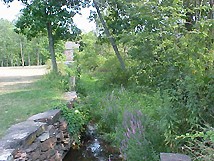 |
|
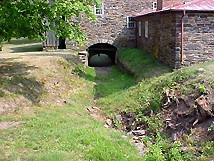 |
| The millrace as seen from the
edge of the dam is overgrown with vegitation today. |
|
Next to the mill, the
mill race is more visible. The water entered the building at the dark
area seen at the center of this photo. |
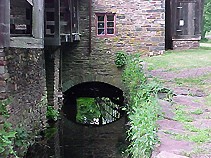 |
|
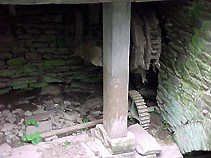 |
| View of millrace downstream
of the mill. |
|
View of part of the mill power system
under the sawmill. |
Changes in the Stover-Myers Mill were primarily
in the type of power used for the mill. For most of its years
of operation the mill relied on water as the power source. How
the water power transferrred its power inside the mill changed
over the years. Gravity was an important force also which was
used to move the grain downward in the mill.
| 
Opening in floor used to allow grain to drop to a lower floor through
a chute
|
|
Gravity was an important force
also used to move the grain downward in the mill.
Only one man was needed to run the mill but occasionally
other workers would help. |
WATER WHEEL
From 1800 to possibly 1834 a water wheel
was used to power the mill. There is no evidence of what the wheel
looked like. The energy passed from the wheel to the millstones
through a series of gears. See the Regional
Mills page to see a wooden waterwheel at the Kintnersville
Mill.
Energy was transferred by two wheels with
teeth that made up the gears. As one wheel turned the other wheel
also turned. The movement of the gears produced friction that
would produce sparks. Animal fat was smeared on moving parts to
reduce friction.
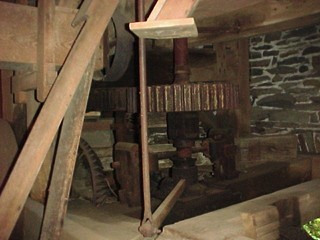 |
|
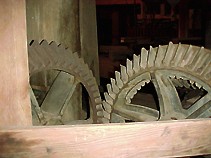 |
| Main gear at the Stover-Myers Mill |
|
Wooden gears were also used to transfer
power to other pieces of equipment in the mill. |
TURBINES
After 1830 (perhaps 1834) the water wheel
was replaced by gravity turbines. The two turbines in place are
dated to approximately 1860. Each turbine is directly connected
to the millstone above them.
 |
|
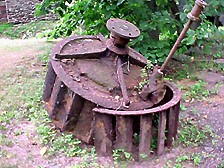 |
| Gravity turbine diagram. |
|
Turbine resting on the ground outside
of the mill. When the mill was working, this equipment was used under
the water. |
ROLLER MILL
After 1885 the mill was converted to a roller
mill. A steam engine was added to the northeast side of the mill
and connected to the main power train of the mill.
ROLLER MILL PROCESS
Grain to be ground flowed from upper floor
storage by way of a chute to the "hopper," or top section
of the roller mill. From the hopper, the grain flowed down between
revolving steel cylinders that crushed the grain. The crushed
grain then fell through an opening under the roller into a chute
which directed the grain to an elevator. The elevator took the
grain (now a rough flour or meal) to the top floor where it was
then sent by another chute to the next roller. This process was
repeated until the grain had passed through 4 sets of rollers.
This made it possible to get much more flour from the grain than
the old millstone method. After the final pass through the last
roller stand, the flour was directed to the gyrators for multiple
siftings.
TRACTOR POWER
In the 1950's a farm tractor was used to
power the mill.







